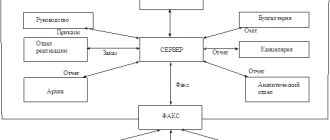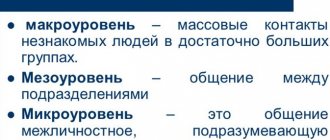Introduction
Body language is a language that almost everyone understands. Usually this happens completely unconsciously, without thinking. Body language is a signal that is transmitted from one person to another, which is why scientists also call this communication “non-verbal communication.” During intimate contact, a glance and touch are more expressive and provide more complete information than many words.
The language of body movements was very important already in Ancient Greece. For example, great importance was attached to posture. A man must hold his head high, otherwise he may be mistaken for a homosexual. Women and children, on the other hand, should not look the other person directly in the eyes. The casual look showed shyness, modesty and submissiveness.
In the XVII-XVIII centuries. In Western countries, books of the century were published on the rules of good sound. For example, in 1735, S. Van Par's book “The Great Ceremonial Book of Good Manners” was published, containing 500 pages.
The first book entirely devoted to gestures was the work of D. Balver “Chirology: either the natural language of the hand and chironomy, or the art of rhetoric of the hands.” And Francis Bacon even proposed creating a science of gestures. In the late 19th century, gestures were studied by anthropologists and psychologists.
In 1939, a three-volume monograph by I.A. appeared in Russia. Sobolevsky, in which the author presented his view on nonverbal communication.
Research into the meaning of human body language continues, as evidenced by international conferences and scientific reports, for example, the collection “Gestures and Moods from Antiquity to the Present,” published in England.
Features of interpretation of non-verbal signals
There are statistics according to which a person receives about 70% of information by deciphering nonverbal signals. This happens directionally or intuitively, but constantly, so it is useful to be able to interpret them.
However, not everything can be recognized and understood correctly. In order to do this competently, it is necessary to distinguish between types of nonverbal communication and know their characteristics. This will help divide the signals into groups and identify the smallest, but therefore more truthful, since they are less obvious and more difficult to control.
At the same time, you shouldn’t get carried away and look for a second meaning where there is none. It is necessary to take into account the character of the interlocutor, the situation, the context and a number of factors in order to interpret the signs correctly, and not try to “read” reactions caused by external circumstances.
Nonverbal Communication
Research has shown that only one tenth of the information a person provides is verbal information. The rest comes from gestures, facial expressions, pantomime, eye contact, touch and intonation. The first intuitive “scanning” of a person takes about 20 seconds. People don't always say what they mean, but the body can't lie. Hidden feelings find their way through gestures. The psychology of nonverbal communication is very broad and complex. Once you learn to understand human gestures and their meaning, it will be much easier for you to know the truth.
When a person’s emotional background increases, he stops paying attention to his body. But when trying to untangle someone else's thoughts, situational factors must be taken into account in order for the judgment to be correct. For example, if a person crosses his arms over his chest in severe frost, this can only mean that he is cold, that he is not closed and not closed.
Let's consider nonverbal means of communication.
The Importance of Conscious Nonverbal Communication
Communication using body language is necessary for complete communication. Communication through gestures enhances what is said, giving it the necessary emotional coloring. In fact, it is various types of nonverbal communication that allow people with language barriers or problems pronouncing sounds to communicate with each other.
Moreover, if in the first case the complexity of the transmitted images can be increased gradually, then in the second this is impossible, since gestures become, in principle, the only means of communication with another person.
Most people communicate using words. People with voice and hearing disabilities are left with only their fingers and face as an alternative to speech and emotions. They use gestures and facial expressions to communicate with each other and others.
Sometimes situations arise when it is impossible to convey something using words: soundproof walls, long distances, noisy crowds. And then non-verbal communication comes to the rescue. Its conscious use can be observed in many places. For example, hunters, divers, and motorists have a system of conventional signs. Possession of them helps to quickly coordinate many actions.
Gestures
Gestures are a lot of hand and head movements. Sign language is the oldest way to mutual understanding. In different historical eras and among different peoples they had their own common way of gesturing.
The intensity of gestures can increase as a person's emotional arousal increases, and also when you want to achieve better mutual understanding between partners, especially when this is difficult.
The specific meaning of individual gestures varies among cultures.
However, all cultures have the same gestures, which we can differentiate between:
- communicative (gestures of greeting, farewell, attracting attention, prohibitions, affirmation, denial, interrogation, etc.).
- modality, i.e. expression of assessment and attitude (gestures of agreement, satisfaction, trust and mistrust, etc.).
- descriptive gestures that make sense only in the context of speech.
Gestures can be open and closed. Overt gestures include movements in which a person places their arms to the side or shows their palms. They indicate that a person is open and ready to communicate. Closed gestures include those that help a person create a psychological barrier. The body can be covered not only by hands, but also by foreign bodies. Such manipulations indicate that the person does not trust the interlocutor and is not ready to open up to him. These can be “closed” fingers or crossed arms.
Literature:
1. Abramov N. The art of talking // Russian speech. - 1991. - No. 4.
2. Vvedenskaya L.A., Pavlova L.G., Culture and the art of speech. Modern rhetoric. Rostov-on-Don. Publishing house "Phoenix". 1996.
3. Goldin V. E., Sirotinina O. B. Speech culture // Russian language. Encyclopedia. - M., 1998.
4. Daletsky Ch. Workshop on rhetoric. - M., 1996.
5. Pease A. Body language. How to read others' thoughts by their gestures. — Nizhny Novgorod, 1992.
Pantomime
Facial expression is the movement of facial muscles, the main indicator of emotions. Studies have shown that when the interviewer's face is silent or invisible, up to 10-15% of information is lost. There are more than 20,000 descriptions of facial expressions in the literature. The main characteristic of facial expressions is their integrity and dynamism. This means that in the facial expressions of the six main emotional states (anger, joy, fear, sadness, surprise, disgust - see Appendix No. 1), all movements of the facial muscles are coordinated. The main information load in facial expressions is carried by eyebrows and lips.
The Importance of Nonverbal Communication
Nonverbal communication is an important addition to basic communication, allowing you to convey much more information to your interlocutor, increase the level of mutual understanding and make any conversation more constructive. Psychologists call 5 main functions of nonverbal signals:
- Duplication. With a gesture, facial expression or intonation, a person can repeat the main message, confirming it, making it more understandable and unambiguous.
- Contradiction. Consciously or unconsciously, a person may show that he meant the opposite. For example, when talking about his intentions, he can wink conspiratorially.
- Substitution of meaning. With your eyes and facial expressions you can not only complement the meaning, but also completely change it or demonstrate that the phrase is said in a figurative meaning.
- Addition to what was said. Certain gestures can convey additional messages. For example, a person can say that he does not want to do something, but show by his facial expression that he is tired of it.
- Strengthening meaning. Kind words can be emphasized with a friendly smile, and an emotional statement can be emphasized by hitting the table with your fist.
Pantomime
Pantomime is gait, posture, general motor skills of the whole body.
Gait is the way a person moves. Its components: Rhythm, step dynamics, amplitude of body transmission during movement, body weight. By gait you can judge a person’s well-being, character, age, and recognize emotions such as anger, suffering, pride, and happiness. It turned out that a “stiff” gait is typical for people who are angry, while a “light” gait is typical for happy ones.
Position is the position of the body. The human body is capable of taking about 1000 stable different positions. Posture shows how a person perceives his status in relation to the status of others present. People with higher status adopt a more relaxed posture. Otherwise, conflict situations may arise.
The most important semantic content of the pose is to position the body in relation to the interlocutor. This position indicates either a closed position (face with arms and legs crossed) or a communication position.
A closed position is perceived as a position of distrust, disagreement, opposition and criticism. Moreover, the interlocutor did not assimilate about a third of the information received from this pose. The easiest way to come out of this position is to offer something to hold or observe.
The open position is a position in which the arms and legs are uncrossed, the body is directed towards the communication partner, and the palms and feet are turned towards the communication partner. This is a pose of trust, harmony, goodwill and psychological comfort.
If a person is interested in communication, he will focus on the interlocutor and lean back, and if he is not very interested, then, on the contrary, he will focus on the interlocutor and lean back. A person who wants to make a statement will be upright, tense, with shoulders turned; a person who does not need to emphasize his status and position will be relaxed, calm, in a free, relaxed position.
The best way to communicate with your interlocutor is to copy his posture and gestures.
Eye contact
Eye contact is also an extremely important element of communication. Looking at the speaker, we can not only feel interested, but also focus on what we are being told. People interacting usually do not look each other in the eyes for more than 10 seconds. If we are not given enough attention, we have reason to believe that we or what we say is being treated poorly, and if we are paying too much attention, it may be perceived as a challenge or good treatment. Additionally, it has been observed that when a person is lying or trying to hide information, their eyes meet their partner's eyes less than 1/3 of the time they speak.
Appearance can be: business, social, intimate, with crossed eyes.
Touch and Setting Characteristics
The role of contact in nonverbal communication. Here handshakes, kisses, caresses, strokes, blows, blows, etc. stand out. The use of contact in communication is determined by many factors: the status of the partners, their age, gender, degree of acquaintance.
Inappropriate use of a person's sense of touch can lead to communication conflicts. For example, patting on the back is possible only if the relationship is close and the social situation in society is the same.
During communication, it is also important to pay attention to voice characteristics associated with nonverbal communication: tone, volume of the voice, its timbre, its involvement in pauses in speech and various non-morphological human phenomena: crying, coughing, laughter, sighs, etc.
It is necessary not only to be able to listen, but also to hear the intonation system of speech, to appreciate the strength and tone of the voice, the speed of speech, which practically allows you to express your feelings and thoughts.
Voting contains a lot of information about the owner. An experienced voice expert can determine the age, place of residence, health, character and temperament of its owner.
Since the characteristics of the voice depend on the functioning of various organs of the body, it also reflects their condition. Emotions change the rhythm of breathing. Fear, for example, paralyzes the larynx, the vocal cords become tense, and the voice “sits down.” When the mind is well disposed, the voice becomes deeper and richer in shades. It has a calming effect on others and instills more confidence.
2.6. Gestures
§ 2.7. Pantomime
Conclusion
Introduction
It is well known how difficult it is to learn a foreign language. How much effort and time do you need to spend? But there is one language on earth that is accessible and understandable to everyone - this is body language, which we use every moment of our lives. And nowadays, in the process of communication and mutual understanding between people, not the least place is given to the so-called “non-verbal communication” - the language of gestures and body movements.
Since scientists first became interested in nonverbal communication, many amazing things have been discovered. Perhaps most surprising is the extremely small number of words that are meaningful in face-to-face conversation, compared with the vast number of signals conveyed through gestures and associated symbols. According to experts, up to two-thirds of messages received by any participant in a conversation come through non-verbal communication channels. Along with speech perception, messages constantly circulate between people, which they receive and to which they react, before consciousness subjects them to rational analysis. If we do not always speak, then we constantly make movements, without even noticing it.
1. The essence of non-verbal means of communication
The role that gestures play in human communication has long been of interest to scientists. Two thousand years ago, Cicero taught orators to gesture correctly, and the first dictionary of gestures apparently belonged to the Roman rhetorician Quintilian, who lived in the first century BC. If we turn to times closer to us, we can name the books of John Boliver, published in 1664, which are devoted to sign language: “Chirology, or the Natural Language of Signs” and “Chironomy, or the Art of Rhetoric of the Hands.” Boliver was the first to compile tables (of those known in European countries) systematizing signs of expressive gestures. Subsequently, the knowledge of expressive human movements was significantly advanced by Charles Darwin's book “The Expression of the Emotions in Animals and Man,” published in 1872. In the 20th century, several dozen major works on gestures were published. Their authors were D. Efron, C. Morris, M. Critchley, J. Fast and others.
Gesture signals of animal communication are species-specific and form “closed” systems. Human gestures have different characteristics. The “openness” of natural gesture systems and the lack of genetic fixation of components determine the possibility of the emergence of both new and borrowed gestures.
Animals, unlike humans, do not have figurative movements; they only have expressive movements. In addition, animal gestures are unambiguous, and when characterizing natural human gestures, it is necessary to note the presence of both monosemantic (unambiguous) and polysemantic gestures. For example, a handshake can mean greeting, farewell, congratulations, approval, agreement; a nod of the head can mean greeting, approval, agreement, gratitude, farewell and a number of others. The choice of one of the meanings depends on the context.
Our external behavior reveals a lot of what is going on and inside us. Only these manifestations need to be able to recognize. Behind individual, barely noticeable manifestations of hands, eyes, posture, you can see the mood, desires, and thoughts of your partner. As a recognized expert on people once noted, it is easier to change your worldview than your highly individual way of raising a spoon to your mouth.
The emotions of those communicating are naturally included in human communication. This emotional attitude that accompanies a verbal utterance forms the nonverbal aspect of information exchange - nonverbal communication.
The means of non-verbal communication include gestures, facial expressions, intonation, pauses, posture, laughter, tears, etc., which form a sign system that complements and enhances, and sometimes replaces the means of verbal communication - words. According to research, 55% of messages are perceived through facial expressions, postures and gestures, and 38% through intonation and voice modulations. It follows that only 7% is left to the words perceived by the recipient when we speak. This is of fundamental importance. In other words, in many cases, the way we speak is more important than the words we say. Most nonverbal forms and means of communication in humans are innate and allow him to interact, achieving mutual understanding at the emotional and behavioral levels, not only with his own kind, but also with other living beings. Many higher animals, including most notably dogs, monkeys and dolphins, are given the ability to communicate non-verbally with each other and with humans.
Thanks to nonverbal communication, a person gets the opportunity to develop psychologically even before he has mastered and learned to use speech (about 2-3 years). In addition, nonverbal behavior itself contributes to the development and improvement of a person’s communication capabilities, as a result of which he becomes more capable of interpersonal contacts and opens up greater opportunities for development.
Means of nonverbal communication, as a unique language of feelings, are the same product of social development as the language of words, and may not be the same in different national cultures. Bulgarians express disagreement with their interlocutor with a nod of the head, which a Russian perceives as approval and agreement, and the negative shaking of the head, common among Russians, can easily be taken by Bulgarians as a sign of agreement.
In different age groups, different means are also chosen for non-verbal communication. Thus, children often use crying as a means of influencing adults and as a way of conveying their desires and moods to them.
1.1. The role of nonverbal communication
Words are good for conveying logical information. At the same time, feelings are better conveyed non-verbally. According to the assessment of sufferers, 93% of the information transmitted during emotional communication passes through non-verbal communication channels.
Nonverbal communication is difficult to control even for professional artists. To do this, they need to get into character, which is a complex creative process that doesn’t always work out and requires rehearsals. Therefore, nonverbal communication is significantly more reliable than verbal communication. We can control some of the parameters of nonverbal communication. But we will never be able to control all parameters, since a person can keep no more than 5-7 factors in his head at the same time.
Nonverbal communication is usually spontaneous and unintentional. Nature gave it to us as a product of many millennia of natural selection. Therefore, nonverbal communication is very capacious and compact. By mastering the language of nonverbal communication, we acquire an effective and economical language. By blinking an eye, nodding our head, or waving our hand, we convey our feelings faster and better than we could with words.
We can convey our feelings and emotions without words. Nonverbal language is also used in verbal communication. With his help we:
- we confirm, explain or refute information transmitted verbally;
- transmit information consciously or unconsciously;
- express our emotions and feelings;
- regulate the flow of the conversation;
- control and influence other persons;
- we make up for the lack of words, for example, when learning to ride a bicycle.
When talking with a partner, we see his facial expressions, gestures that tell us what our interlocutor really thinks and feels. Thus, the seated interlocutor, leaning forward, tells us that he wants to speak himself. Having leaned back, he himself wants to listen to us. A chin tilted forward indicates strong will, a desire to strictly monitor one’s interests. If the chin is raised and the head is straight, then the partner considers himself in a position of strength.
By controlling our non-verbal language, we can evoke the image we desire. When speaking to an audience as an expert, we should evoke the image of a competent, confident specialist. Otherwise, no one will believe our opinion. Moreover, the audience will form their impression of us in the first few seconds of our speech.
If we walk onto the podium with a slouched back, a sluggish voice, and a slurred voice, we are unlikely to be able to convince those present to accept our proposals, unless the audience already considers us to be a first-class specialist and an unquestionable authority.
Nonverbal language helps us form a clearer and more adequate opinion about our partner. Tapping your fingers on the arm of the chair indicates nervous tension. Clasped hands indicate closedness. The predominance of consonants in speech is about the predominance of logic over feelings: the interlocutor is more likely a “physicist” than a “lyricist.”










